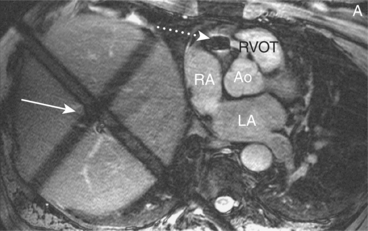Chapter 9 Coronary MRA
Introduction
Coronary MRA is technically demanding since the coronary arteries are small, tortuous vessels embedded in epicardial fat that move with cardiac and respiratory motion.
Coronary MRA techniques
Free breathing combined with 3D imaging provides good signal-to-noise ratio (SNR) and anatomical coverage. GE sequences image blood within the coronaries, and SE sequences image the vessel wall. Subjects breathe normally throughout the scan and respiratory artefact is minimized by the prior addition of respiratory navigators. These provide a way of monitoring respiratory motion during data collection and correcting that data for the motion. Methods of motion assessment differ, and one commonly used is detection of the superior–inferior movement of the dome of the right hemidiaphragm (Figure 9.1). Following placement and navigator initiation, the user automatically accepts data when the diaphragm–lung interface falls within a pre-defined window and rejects data that fall outside this narrow limit. The acceptance window is positioned at the end expiratory pause period of the respiratory cycle and extends 2–3 mm either side of a patient-specific diaphragm–lung interface value.
Free breathing sequences acquire data over several minutes and provide higher resolution than breath-hold techniques. Breath-hold 3D GE coronary MRA requires subjects to suspend their respiration for 20–25 s depending on their heart rate. Since navigators are avoided, breath-holding requires less expertise and circumvents problems arising from suboptimal respiratory patterns. The resolution and coverage sacrificed with the breath-hold option becomes relevant at the limits of coronary MRA indications, such as evaluation of coronary artery stenoses, and is not of significance for delineation of proximal coronary artery origin and early course. With free breathing SSFP GE coronary MRA a typical spatial resolution is 1.1 ×0.7 ×1.5 mm3 with 30 to 48 mm through-plane coverage, as compared to 1.3 ×1.1 ×1.6 mm3 with 16 to 19.2 mm through-plane coverage using the breath-hold sequence. Breath-holding permits several volumes of interest to be imaged in the same time it takes to perform one free breathing scan. Patients do vary in their response to the two methods with consequent compromise to image quality and diagnostic accuracy, and both may need to be attempted (Figure 9.2). Maximal and optimal resolution with either technique is not equivalent. Maximizing resolution will assist accuracy but will reduce SNR and lead to grainy images, while optimal resolution may be a little lower but produce better quality scans. Post-processing curved MPR is an excellent way of presenting findings in coronary MRA reports (Figure 9.3).






